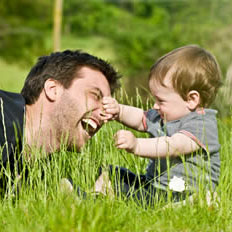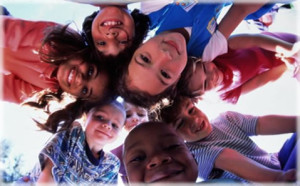 Babies may seem happy to simply sit in a pram, a bouncer or a constraint conveniently placed in front of the TV and older children are typically happy to sit in front of a ‘screen of pleasure’ for hours. It is incredibly important however for both our children’s physical and mental health that we do not ‘containerize’ our young children more than absolutely necessary nor habitually over-stimulate and entertain our children.
Babies may seem happy to simply sit in a pram, a bouncer or a constraint conveniently placed in front of the TV and older children are typically happy to sit in front of a ‘screen of pleasure’ for hours. It is incredibly important however for both our children’s physical and mental health that we do not ‘containerize’ our young children more than absolutely necessary nor habitually over-stimulate and entertain our children.
“Why?What’s the harm?” you may ask,
“It’s a win/win situation, isn’t it?” Our little one is happy and we can tackle that To-Do list.”
By repeatedly keeping a youngster in a pram, high chair or play pen and not allowing them to explore and experience the world around them can have serious consequences for their motor and cognitive development. Babies and young infants learn through their environment and the valuable feedback that it provides.
With parents being busier than ever before, it is also tempting to place infants in front of educational DVD’s and parents may believe that these DVDs can stimulate my baby better than me?” Well, research suggests otherwise.
Interestingly, a survey of over 1,000 parents of 2 to 24-month-old babies1 found that for each hour per day that an infant watched a ‘brain-training’ DVD, there was a significant decrease in the pace of language development. This was compared to the act of reading increase in language scores, while the DVD viewing was associated with a 17-point decrease.
This research suggests that while infants learn quickly about their world by watching parents or caregivers, much less is learned when this information is presented via audiovisual media. The fact that the DVDs attract the attention of infants does not mean they induce learning. The American Academy of Pediatrics officially recommends parents avoid screen time for children under the age of two years: “These early years are crucial in a child’s development… Any positive effect of television on infants and toddlers is still open to question, but the benefits of parent-child interactions are proven.”
Indeed, there seems to be no adequate substitute for making time to bond and connect with our children. By switching on, we may be switching off more than we bargained for.
So How Do Young Children Learn?
Babies spend nearly half of their waking time doing things like waving their arms, kicking and bouncing, and while it may appear all this activity is pointless, a baby is never ‘just moving’ or ‘just playing’; every action extends the development in some way. We need to allow all children regardless of their age – plenty of time to play or entertain themselves independently.
In addition to spending time with your youngster, reading, chatting and playing games, whenever possible allow them time to simply move about, explore their world and entertain themselves with a variety of objects, such as cups, balls, spoons, string, a plastic mirror, etc. Every time a child reaches out to touch something new their neurological synapses connect eventually building circuits that are strong enough to trigger the next developmental milestone.
As your child grows older, teach them to do stimulating activities like blowing bubbles, balloons or whistles, to build with blocks,to count beads, play cards, memory games and puzzles.
 Children Need ‘Time Off’ As Well
Children Need ‘Time Off’ As Well
Of course, beware the trap of trying to force your child to do ‘constructive’ activities ALL the time. Children need ‘time off’ as well, which means just letting them entertain themselves and initiate their own activity, whether that involves making something, reading, drawing or just daydreaming. Imaginery play is incredibly important too. The take home point being – it is important they be allowed to take initiative, to have unstructured time which encourages their own form of creative activity.
For the young child, imaginative free play is especially important because it nurtures the kind of creativity which will be transformed into creative thinking. It is excellent preparation for reading, where written symbols must be corresponded with objects, actions and abstract concepts. When young children are using their imaginations in play, their brains are working and developing in a much healthier way than when they are being made to sit and copy pages from a workbook, for example.
I believe one of the most important roles we have as a parent is to encourage our child to be “happy” in their own skin, “happy and content” with their own company. As our child grows there are few things better than observing our child cuddled up on the couch, lost in a great book, delightedly playing with their pet, or sitting high up in tree peacefully watching the clouds.
What Do I Do if I Feel That Child Might Be Struggling To Learn?
This is a topic I discuss with parents all the time. My first suggestion would be to assess their developmental milestones yourself. You can download a copy of our Developmental Charts or grab a copy of Ticklish – New Ways To Help Your Child Learn, Love and Play. Here you’ll find information and charts regarding movement, behaviour and language your baby should ideally be demonstrating at different ages are called age-appropriate developmental milestones. Knowing these kinds of milestones can be a useful guide to help ensure your child’s brain is wiring and firing in an ideal manner, and whether to take action if your child needs additional help.
The second most important thing I would suggest is having your child’s nervous system checked by a family wellness chiropractor. Clinical studies indicate that rapid growth of the entire brain occurs during the first year of life. Physical, chemical and emotional stressors impact the nervous system of babies and infants so it makes sense to ensure your baby’s nervous system is communicating clearly and at an optimal level.
The Journal of Neuroscience (2008) states that, although the first year of life may be a period of developmental vulnerability it may also be a period in which therapeutic interventions would have the greatest positive effect.
To maximize your child’s brain and nerve communication have them assessed by a chiropractor skilled with children.
I discuss these concepts in greater depth in Ticklish….
. . . . .
Yours in health…
Jennifer Barham-Floreani
Bach. Chiropractic, Bach. App Clinical Science
Registered internationally, no longer practicing as a chiropractor in Australia.
1. Zimmerman, F. J., Christakis, D. A., Meltzoff, A. N. 2007. Associations between media viewing and language development in children under age 2 years. Journal of Pediatrics, 151. 364–368.
2. Bavelier, D., Green, C. S., Dye, M. W. G. 2010.
Children, wired: For better and for worse.
Neuron, 67. 692-701.
3. American Academy of Pediatrics. 2006. AAP – TV AND TODDLERS. [ONLINE] Available at: https://www.aap.org/sections/ media/toddlerstv. htm. [Accessed 22 July].
4. Knickmeyer, R.C., Gouttard, S., et al 2008. A structural MRI study of human brain development from birth to 2 years. The Journal of Neuroscience, 28 (47). 12176 –12182.





